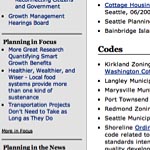|
Finding or Building a Pocket Neighborhood: Planning Officials

Innovative Codes for Your Planning Toolbox
Since 1995, cities and towns across America have been including Cottage Housing Ordinances in their zoning codes. These innovative codes provide incentives to land owners and developers to build smaller, community-oriented homes on infill sites. Having them in your planning toolbox will encourage housing diversity and affordability, and help to preserve the scale and character of existing neighborhoods.
To learn more about these codes, click through to the following links:
Municipal Research and Services Center
City of Langley, WA, code: Chapter 18.22.180 http://www.codepublishing.com/WA/Langley/
Pocket Neighborhood website / Pocket Neighborhood Codes
Model Code for Larger Sites
Cottage Housing codes work well on infill sites less than one acre in size and for smaller household sizes. For larger sites and a wider variety of household types, Ross Chapin Architects has written a model Pocket Neighborhood Community Development Code. This code primarily uses Pocket Neighborhood Clusters to encourage a stronger sense of community and security among nearby neighbors, while also preserving personal privacy. Secondary configurations in the code are street-oriented porch-fronted dwellings with rear-access lane parking.
Planning for Livable Communities
Pocket Neighborhoods are best when nested within a larger, walkable community. These are some of the organizations we’re following to stay up on these leading trends:
Congress for the New Urbanism
Placemakers blog
Walkable and Livable Communities Institute
Pocket Neighborhood Codes
Missing Middle
Strong Towns
|